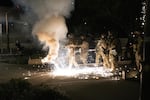A U.S. marshal who severely injured a protester by shooting him in the head during the 2020 unrest in Portland, used “reasonable and privileged” force, attorneys with the U.S. Department of Justice argue in court documents that are part of a civil case set to go to trial next month.
The federal government contends the officer — identified in court documents as John Doe 1 — wasn’t aiming for Donavan LaBella’s head when he shot LaBella with less-than-lethal impact munition on July 11, 2020. Federal lawyers wrote that the gas mask the officer wore made it difficult to aim the launcher when they fired the munition.
“Unfortunately, the impact round did not strike Mr. LaBella in the abdomen, where John Doe 1 had aimed,” attorneys for the U.S. Justice Department wrote. “Instead, it struck him in the head. The evidence will show that the fact that John Doe 1 was wearing a gas mask and did not obtain a good ‘cheek weld’ (aligning his eye along the barrel and the sight) are the most likely explanations for this result.”

Donavan LaBella was shot in the head in 2020 by a U.S. marshal and suffered a frontal lobe skull fracture during protests against racism and police violence in Portland.
Courtesy of the family
The government’s attorneys wrote John Doe 1′s actions are not a factor when determining use of force because the officer didn’t intend to injure LaBella, during a chaotic evening. They also point out that seconds before he was shot, LaBella lifted his arm and tossed back a gas grenade that an officers fired at a crowd of protesters.
“Although Mr. LaBella’s injury is undeniably unfortunate, the United States is not liable under applicable law,” the Justice Department attorneys wrote.
Apart from a brief statement after the incident, the government’s filing is the first time federal officials have laid out their version of events. It’s also the first time the Department of Justice has expressed any views on law enforcement’s culpability. LaBella’s injury was one of the most high-profile instances of violence when federal law enforcement surged into Portland amid protests against police violence following the murder of George Floyd by an officer in Minneapolis.
The trial memo comes ahead of a five-day trial set to begin June 10. Senior U.S. District Court Judge Michael Mosman, a highly respected and deeply experienced jurist who spent 13 years as a federal prosecutor before he became U.S. Attorney in Oregon from 2001-2003, will preside.
Since his injury, LaBella has undergone multiple surgeries and has a permanent injury to his brain “equated by medical professionals to a frontal lobotomy,” according to a lawsuit filed on his behalf in 2021. Specifically, LaBella has frontal lobe syndrome, which affects higher brain functioning, such as language, social behavior, planning and motivation, attorneys for the Justice Department wrote.
They did not dispute the $918,045.45 in medical bills LaBella presented as evidence as a direct result of the incident.
“Mr. LaBella has since made a remarkable recovery, given the extent of his injuries,” attorneys for the Justice Department write. “He currently lives alone. Although he will require continued medical care, plaintiff’s expert notes that Mr. LaBella ‘remains independent with basic activities of daily living, including dressing, grooming, bathing, eating . . . and housework.’ Mr. LaBella needs a conservator to look over his finances. He also likely needs a medical guardian who can make medical appointments for Mr. LaBella and ensure that he attends those appointments.”

FILE: Federal law enforcement officers fire impact munitions and tear gas at protesters demonstrating against racism and police violence in front of the Mark O. Hatfield federal courthouse on July 16, 2020.
Jonathan Levinson / OPB
LaBella’s lawsuit doesn’t seek a specific dollar amount from the federal government and officer who shot him, but in the government’s trial memo, they note experts hired by his lawyers say he should get $308,425 per year — $17 million over the course of his life — to live in a full-time care facility.
“But the evidence will show that there is no need for Mr. Labella to live at such a facility because he is able to independently handle his activities of daily living,” attorneys with the Justice Department write.
Not only does LaBella not need that level of care, the federal government argues, but he doesn’t want to live in such a facility and is not likely to stay.
Desiree LaBella, Donavan’s mother, told OPB when the lawsuit was filed that the injury changed her son’s personality. He became short-tempered, at times, and unable to work, she said. For months, he was living in a tent in Portland.
“As much as we wish it didn’t have to come to this, he’s irreparably damaged,” Desiree LaBella said at the time.
LaBella’s attorneys filed their trial memo under seal, making it unavailable to the public.
“We look forward to presenting our case to the court for their consideration,” James Healy, one of LaBella’s attorneys, said Monday. “We believe the facts will be different at trial.”
Little is known about John Doe 1, other than that the officer was one of hundreds who deployed to Portland during the summer of 2020. The deputy U.S. marshal is a member of the agency’s Special Operations Group and trained on how to use less-than-lethal devices, according to the Justice Department. The officer has no disciplinary history and was deployed to Portland on July 3, 2020, as part of a 12-person special operation team “to assist with protecting the federal courthouse and personnel during the protests and civil unrest.”
The government trial memo references the chaos of that night, leading up to John Doe 1 firing a munition at LaBella. Earlier that evening, a man who tried to break into the federal courthouse in downtown Portland, attacked a deputy marshal with a hammer. Protesters also threw rocks and other objects at the officers — all in one night during months of protests that summer.
Around 9:47 p.m., a special agent with the U.S. Customs and Border Patrol’s tactical unit called BORTAC, “deployed a gas grenade towards protesters” near the courthouse, attorneys for the Justice Department write. LaBella was there, bent down and picked up the grenade and threw it back, they said.
The memo goes on to include what the officer says they saw.
John Doe 1 “observed an individual (Mr. LaBella) picking up a chemical munition (the grenade) and throwing it back towards officers,” the Justice Department’s trial memo states..
The deputy marshal then said they “took aim at the subject’s (Mr. LaBella) abdomen as the subject’s body movement was indicative of throwing another object at him and his fellow officers. [John Doe 1] deployed a single less-lethal impact munition and observed the subject fall to the ground between two vehicles. The suspect was immediately surrounded by other protesters at which time [John Doe 1] and other officers lost sight of the subject.”
The series of events took approximately 10 seconds.



